Carly Lehner, Head of Revenue Enablement, Andela, gave this talk at the Revenue Acceleration Festival in March 2021.
In this article, I’m going to take sales enablement metrics back to basics and discuss enablement metrics 101.
I’ll talk about why metrics are important in enablement, which metrics to use, and how to use data to inform enablement programming, sharing examples and best practices from my career to date.
My name's Carly Lehner, and in this article, I'll be talking about enablement metrics 101. Before I dive in, let me tell you a little bit about myself.
About me
I’m currently the Head of Revenue Enablement at a company called Andela. I just started this job two months ago, previously, I was the Head of Sales Enablement at a company called Axiom.
I live in London, but I am from the US and from Portland, Oregon. I've been in London for three years now, been living in lockdown for the last year and I'm anxiously waiting for the pubs to reopen.
My husband and I have an 18-month-old cockapoo, and we absolutely are so excited that we had a dog through this whole COVID situation, it made staying inside a lot easier.

About Andela
At Andela, we believe brilliance is equally distributed throughout the world, but opportunity is not. We are on a mission to connect companies with vetted remote engineers and those engineers just happen to come from emerging markets.
As I said, brilliance is evenly distributed, opportunity is not.
At the bottom of the image, you can see some of our investors. We were founded in 2014, still a relatively new-ish company, we have over 1300 software engineers in our network and over 200 different clients that we work with.
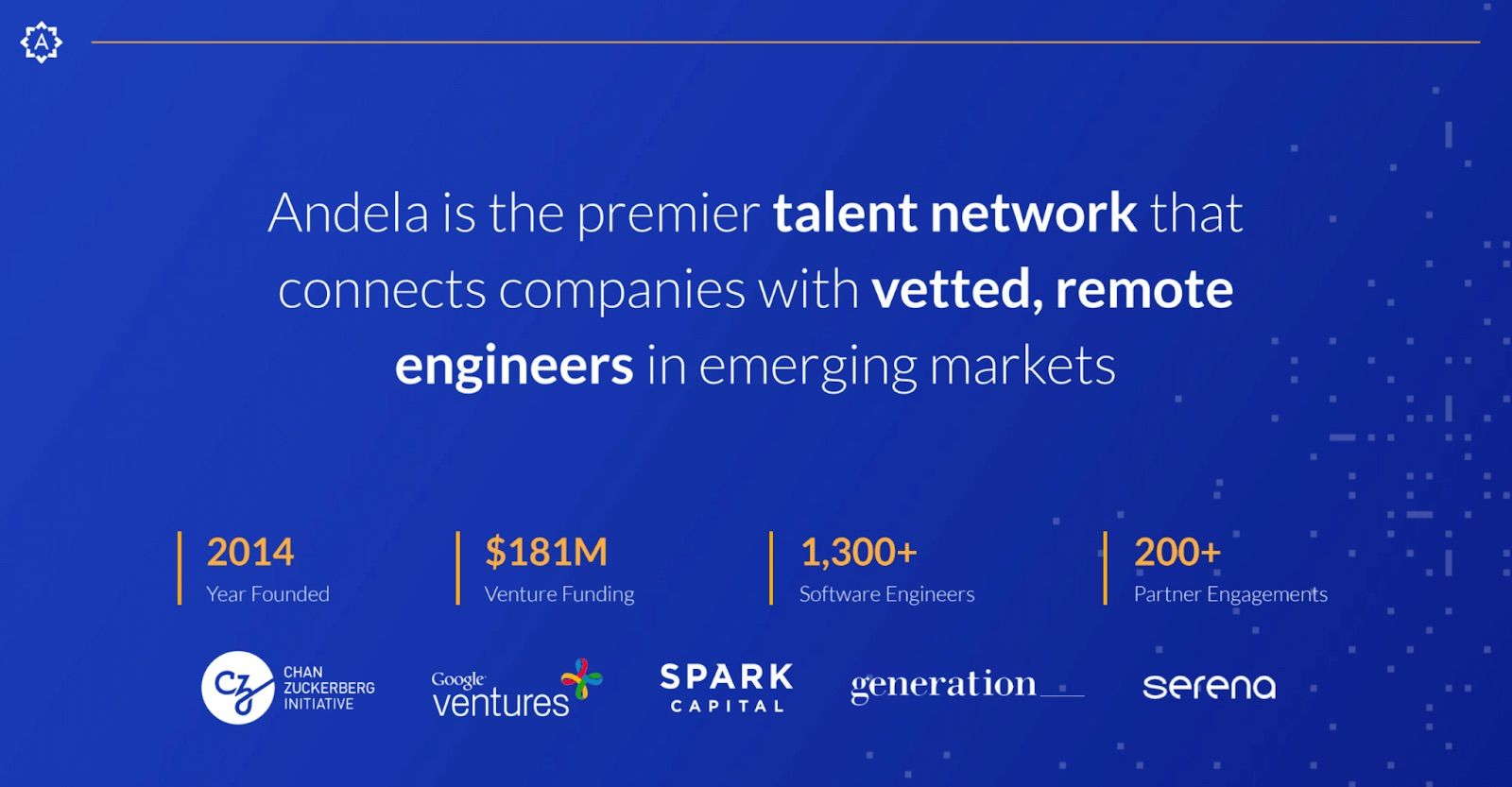
Our talent network
Our talent network spans a couple of different geographies, I said they're in emerging markets, but our primary geo is the continent of Africa.
Andela used to be a company where we would train software engineers, junior engineers, we had five different offices across Africa in Kenya, Nigeria, Uganda, Egypt, and Rwanda, and we would actually train people to become software engineers, and then engage them with companies like Google, Microsoft, Facebook, that sort of thing.
Connecting talent with opportunity.

As we've grown upmarket, and grown-up as an organization, companies want mid and senior-level engineering talent as well. That's really where we started to shift our focus. But we started off with this mission to bring together some opportunity for talent everywhere, not just in the US.
Secondary geos we have are Latin America and Eastern Europe, there's a big community out there in Brazil for Ruby talent, which is one of the software languages, which I didn't know before joining Andela.
So we're really focused on Latin America, and Ukraine has a lot of software engineers as well.
The agenda
I'll cover some basics about enablement metrics.
- Why metrics are important,
- Which metrics e should use from an enablement perspective,
- Using metrics to inform your enable programming, and
- I'll talk a little bit about reporting.
Why metrics?
Why do we even need to bother with all of these numbers and data?
Roadmap building blocks
Honestly, metrics are the roadmap building blocks for enablement. If you guys asked 10 sales leaders what their definition of enablement was, you'd get 10 completely different answers. I'm sure all of you reading who are in enablement would 100% agree with this.
Everyone's definition is really different so it makes a lot of sense to align on some metrics to help define the goals of the department and use those mutually agreed upon metrics with your executive sponsors in your enablement charter, business plan, or your roadmap (whatever you want to call it), to really help define what the function is going to be responsible for.
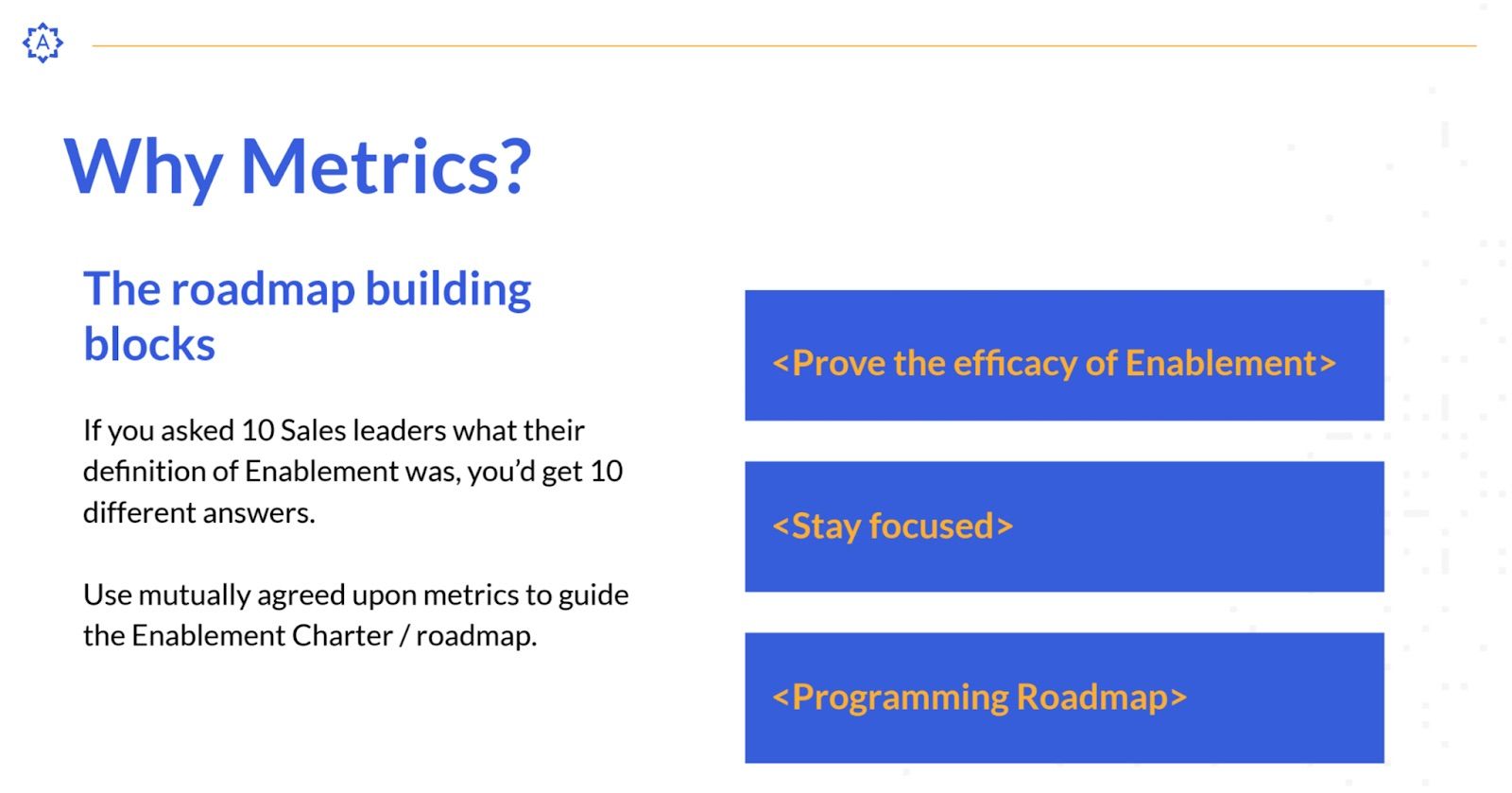
Three things I think about metrics.
- It helps prove the efficacy of enablement.
There are so many different definitions out there but it's also a relatively new function for some companies so you want to be able to go back and say, "Yes, executive team, enablement is making a huge impact on the revenue team, and here's how".
Executives like to speak with data, they like to make their decisions with data. If we come to the table with that data, I think it really helps prove that efficacy.
- It helps us stay focused.
If you talk to any enablement leader, there are emails, Slacks, we’re inundated with requests to do literally anything and everything.
- Can you make a training for this?
- I need a new onboarding program for this.
- I need a new playbook for this.
- Oh, we have new products coming out, can we do product training for this and a certification?
- We need a new pitch deck and we need some new messaging.
I literally could go on forever. Staying focused as an enablement team is really, really difficult when you have all these requests coming at you, and I have fallen victim to this, looking back at the end of the year and thinking, what did I do this year? I just responded to a bunch of non-urgent, urgent requests, did I move the needle in the entire revenue org?
Having metrics to go back to helps you stay focused. If someone asks you to do this whole big program and it doesn't ultimately influence one of the metrics you're trying to influence, then don't do it.
Say, "Hey, this is what the leadership team wants. This is what we're going to focus on. This is a bit out of scope for enablement". It's really hard to say no, but you can use metrics as playing the bad cop, essentially.
- Metrics can help inform your programming roadmap.
I'll show you later on how I look at a set of data and metrics and build programming backward from that.
Which metrics?
When I'm writing out my charter or business plan, (which is something I'm doing right now two months into my new role), when I think about which metrics I want to focus on in enablement and trying to influence, I need to start at the very top.
Company’s revenue goal
I need to start with what the company is hoping to achieve. Every company is going to have a revenue target so that's a really good place to start.
Let's say, for example, your company target is $100 million, and last year you did $75 million. You want some pretty significant growth. When you're thinking about how enablement can support achieving that revenue goal, my mind initially goes to two different questions I want to ask my executive sponsor - the Chief Revenue Officer.
Scale current team size?
The first one is, are we going to achieve this by scaling our current team size?
- Are we going to grow our sales team and bring on a bunch of new sellers?
- Are we going to scale Customer Success account management?
- How are we going to do that?
- Is it a yes or no?
Yes - Onboarding effectiveness
If we are going to bring on a bunch of new hires, we want to make sure onboarding is super effective. There are some metrics in there we're going to want to align enablement to that ultimately if we succeed there, then we will ultimately succeed in helping bring the revenue into the organization.
No - Team productivity
Now if we are not going to scale the team, but we still have this very big ambitious revenue target, team productivity is going to be the most important thing to focus on that year.
Because you need to get more revenue out of your existing team and if it was that easy, why didn't we just do it the year before? Team productivity is something that's super important, and I'll show you some sample metrics shortly.
So I've learned about my current team size and whether or not we’re going to scale it.
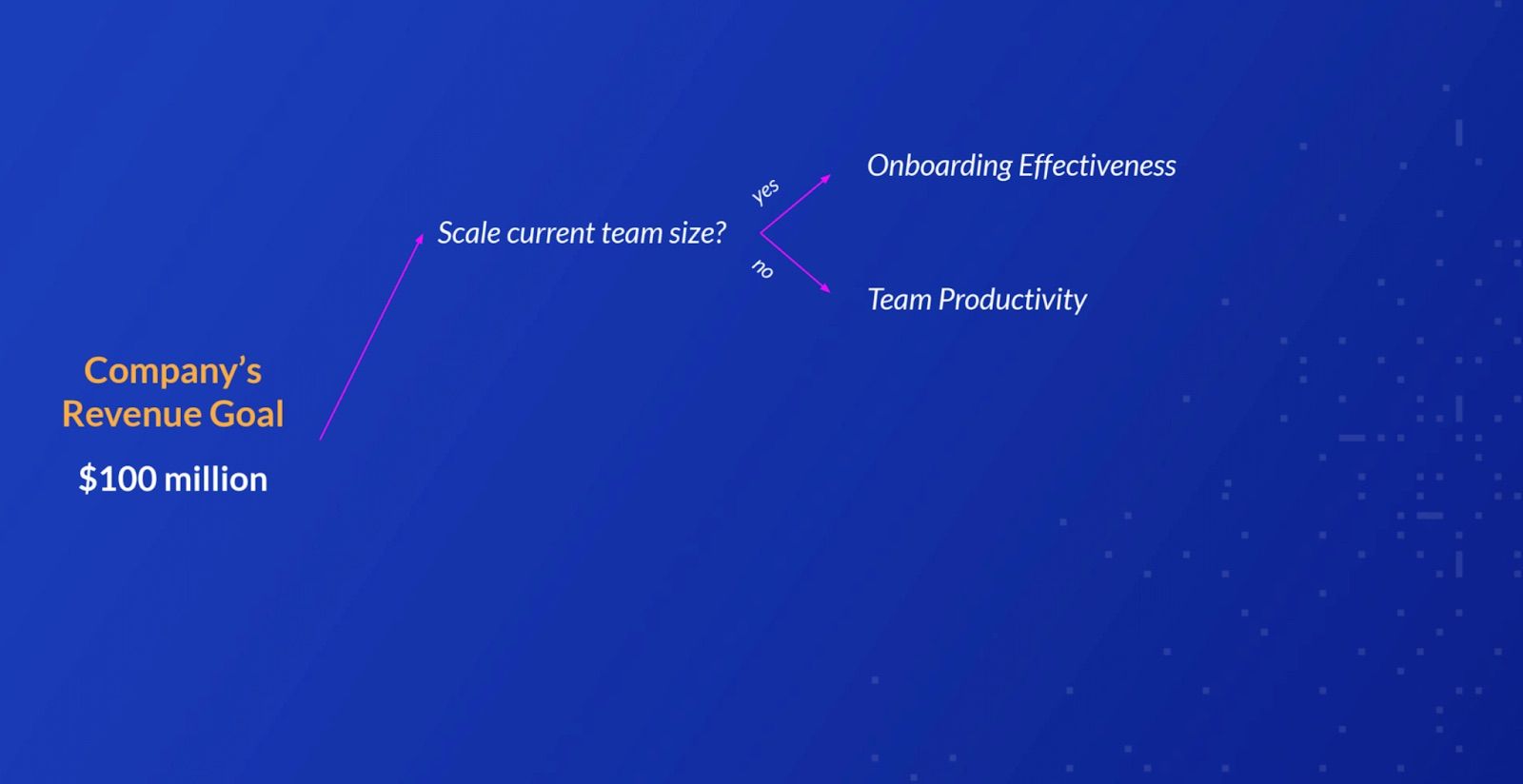
Expand product offering?
The other question I would ask my CRO is are we planning on expanding our product or services?
- Are we hoping to get this incremental revenue from our existing catalog, or portfolio of products?
- Or are we going to introduce some new stuff to the market for sellers to sell?
Yes - Product certification(s)
If we are, product certifications are probably going to be necessary - new products coming in, we've got to get everyone up to speed and confident to be able to pitch them and go into the market.
No - Explore further
If we're not, we want to explore a little bit further what exactly the approach could be from a metrics perspective to help inform our programming down the road.
Onboarding effectiveness
Sample metrics
These are just a few, there are plenty more out there but these are the ones I typically gravitate towards and these are in my charter I have at Andela.
Time to sales qualified lead
The first one is time to sales qualified lead or SQL. From the day someone starts at Andela, to the time they have their first SQL, what is that timeframe?
But also, how does that compare to the trailing 12-month average? Or the 2020 new hire cohort, what was their average? And how can you compare that?
It's a little bit difficult with the pandemic, I know a lot of sales teams have had challenges, to say the least, because of the pandemic so if you need a more apples to apples comparison, perhaps use 2019 data and see how effective your onboarding program is at influencing that metric.
Time to first sale
This one I take with a grain of salt.
There could be a number of different factors to what helps a new hire land their first sale, someone could have warmed the client before they got there, and just handed it over to them, it could have been an inbound sale that was ready to buy and the seller could have been anyone.
No disrespect to new hires but sometimes new hires get lucky. That's great and it's great for confidence building but it's also not super helpful to know how effective your onboarding program is.
I like to look at time to first sale but also time to second sale is really good, and what the difference between those is. I've also seen some other companies look at a time to first generated opportunity and sale. So let's have them start completely from scratch, cold turkey, brand new logo, and bring one in and evaluate it that way.
These are some metrics that I look at but time to first sale is kind of a sticky one.
Time to quota
This is a pretty obvious one, but how long does it take for them to get to their year-to-date quota expectations? I hope everyone reading is giving their new hires a ramp quota. If you're not, I suggest you talk to your Rev Ops team and perhaps make that shift.
Even if their quotas are small quotas, achieving quota, especially early on in your sales career helps build confidence. We want to make sure a confident sales team is a productive sales team.
Having that time to quota and really looking at that is super important when you look at your overall onboarding program and how effective it is. If we're trying to get to that $100 million in revenue and scale the team we need to bring people in quickly and get them ramped quickly so onboarding is the pillar to do that.
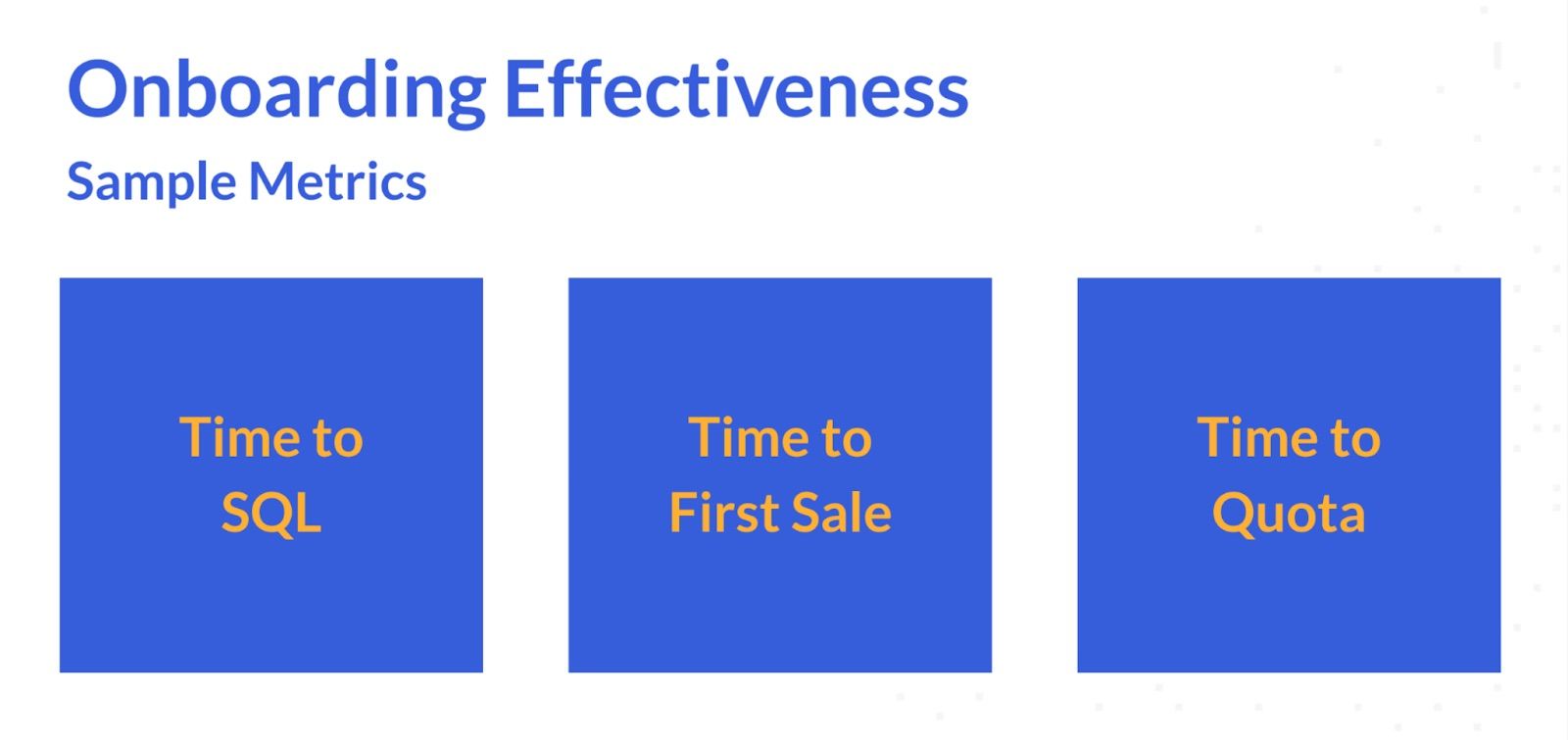
These metrics, I think are super helpful. Obviously, just a few, but some of my favorites.
Team productivity
I personally love these metrics.
Sample metrics
Quota attainment
We all look at this but if 75% of your sales team is not at 75% of their year-to-date quota or better, then perhaps we should look into this a bit more and where we could potentially influence the sales process to get everyone to quota. I'll walk you through an example shortly.
Contribution consistency
This is a personal favorite and something we started doing at Axiom last year was measuring this. You can do it in a couple of different ways.
At Axiom, we expected our sellers to bring in two new deals every month. We would track in a given quarter, how many months did our sellers win a deal. If they did all three, 100%, 66%, 33%, or zero.
Contribution consistency and quota attainment are not the same, but are super helpful, especially when looking at them together. If I have someone who's meeting quota but is super inconsistent in their contribution, I can probably wager they have these high-value deals coming in.
That’s great but they maybe have some pipeline management issues we could try and diagnose, coach them on, and get them to that contribution consistency we expect of our sellers.
Quota attainment is a good story, contribution consistency is an even better one.
Time spent selling
This is probably the hardest metric to measure. I personally haven't cracked this yet.
But if you think about the amount of time sellers spend in internal meetings, talking to the product team about the roadmap and giving field input, or pipeline meetings, all these internal meetings take away from selling and a salesperson we need them to sell, right?
In enablement, one of the things I always try and do is protect the reps’ calendars. I am super strict about putting more than one hour a week on the reps’ calendars that have to do with any training or anything besides selling - keep that to a minimum.
And then working with teams to streamline the number of meetings we have, that sort of thing. If we can even improve time spent selling by 5% imagine the type of returns we could get from that.
This is a really hard one, I don't know how to measure time spent selling unless I actually pull calendar data and get IT to help me work out how many hours a week our reps are in non-client-facing meetings and go from there.
But there's a lot of consulting agencies that actually help with this that could be a good starting point if this is a big area of concern for you.
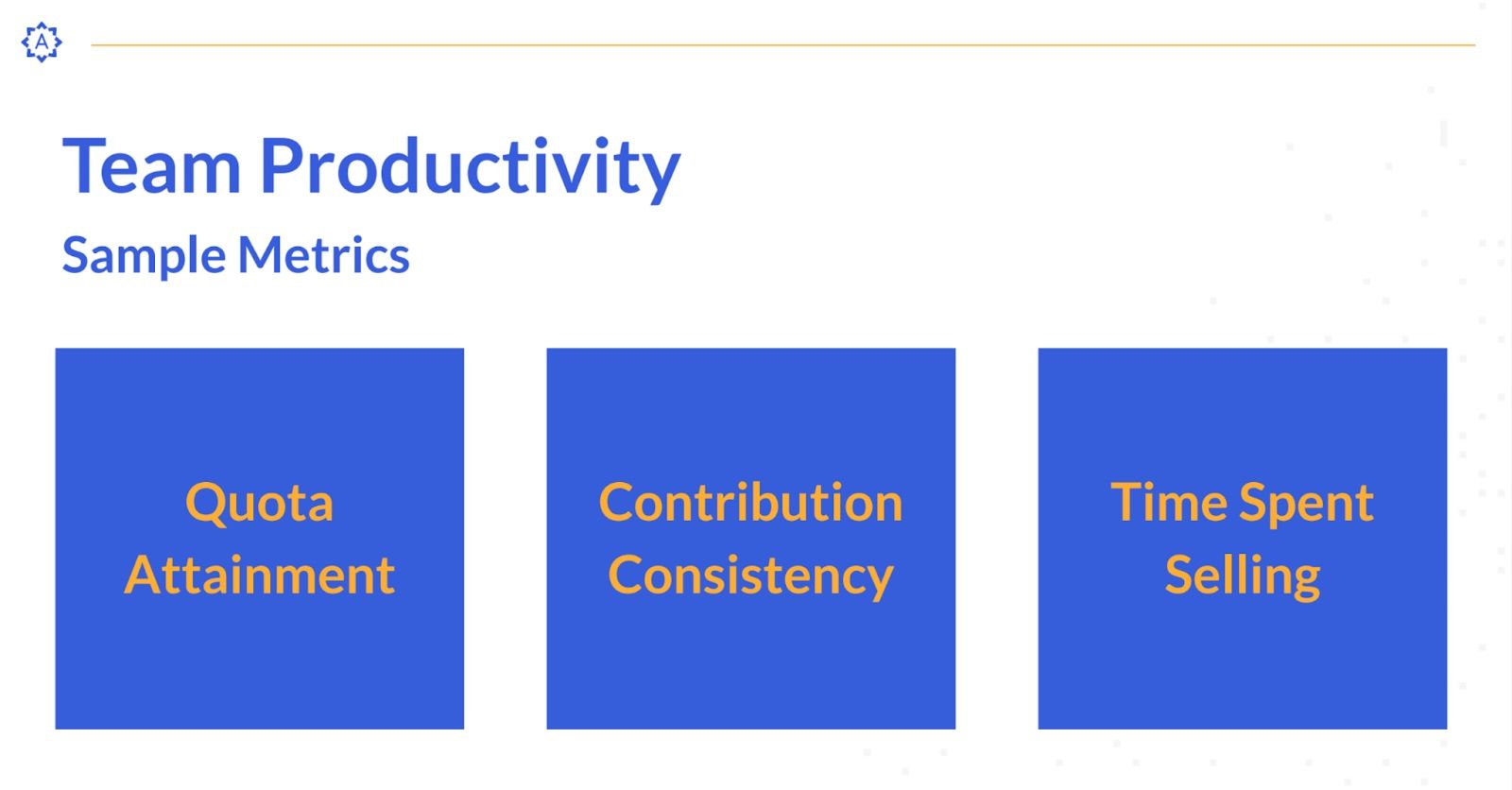
Product knowledge
Sample metrics
With your product knowledge, if you have a wide portfolio of products and services, chances are you also have revenue targets for each of those parts of the portfolio, which ultimately feed up to your overall revenue goal.
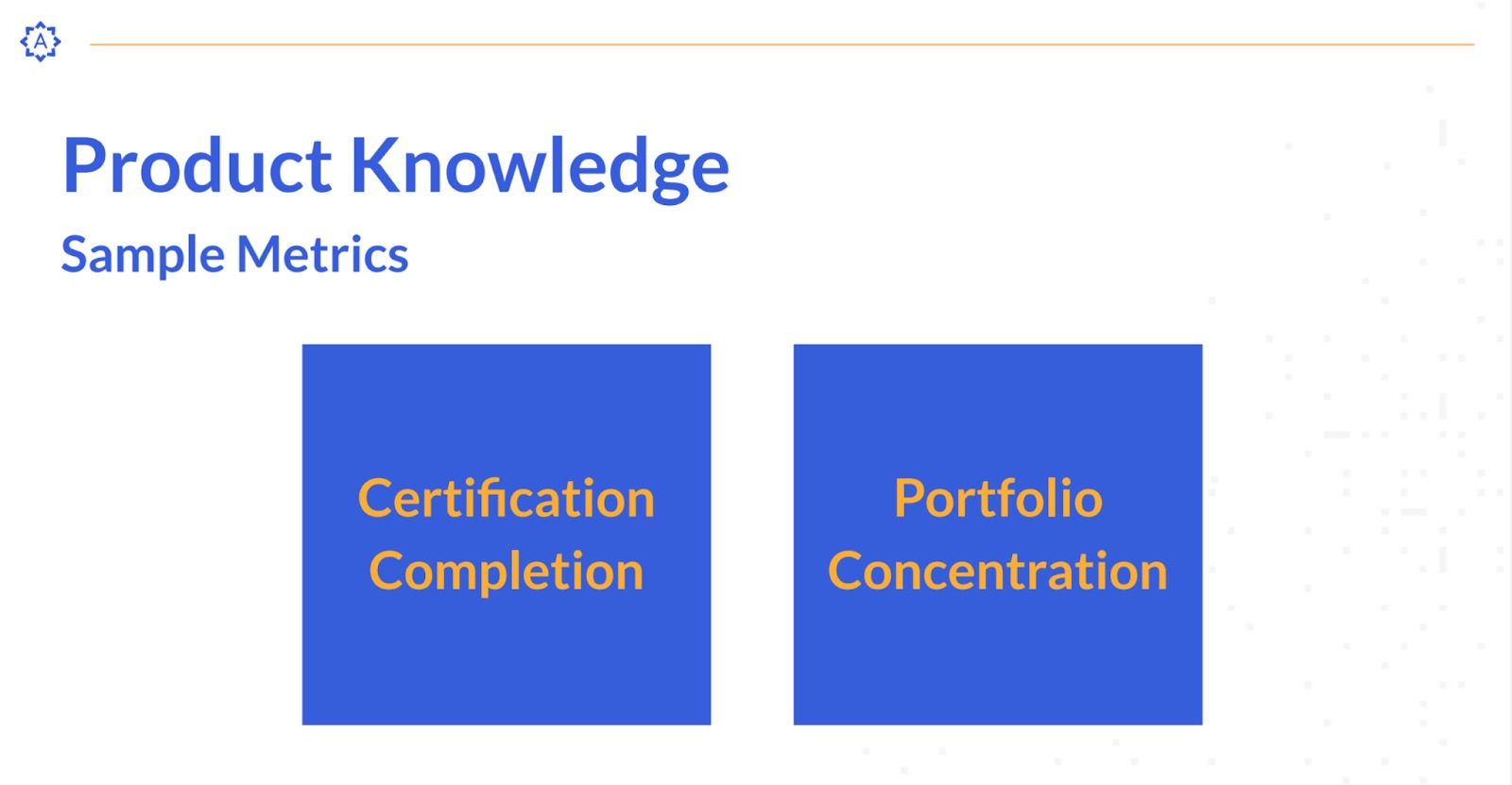
Portfolio concentration
One of the things you can do is look at the portfolio concentration of what people are selling and see if that aligns with the expected distribution from a revenue targeting perspective.
If we expect product A is going to be our breadwinner for the organization but product B is what sellers are selling the most, there's a discrepancy there and we need to figure out why.
Certification completion
I like to go back to basics and do certification completion, retrain everyone on product A, and really focus on product A for a while and make that the focus of the team from a training enablement coaching perspective.
Again, some sample metrics around product knowledge and remember, a confident sales team is a productive sales team.
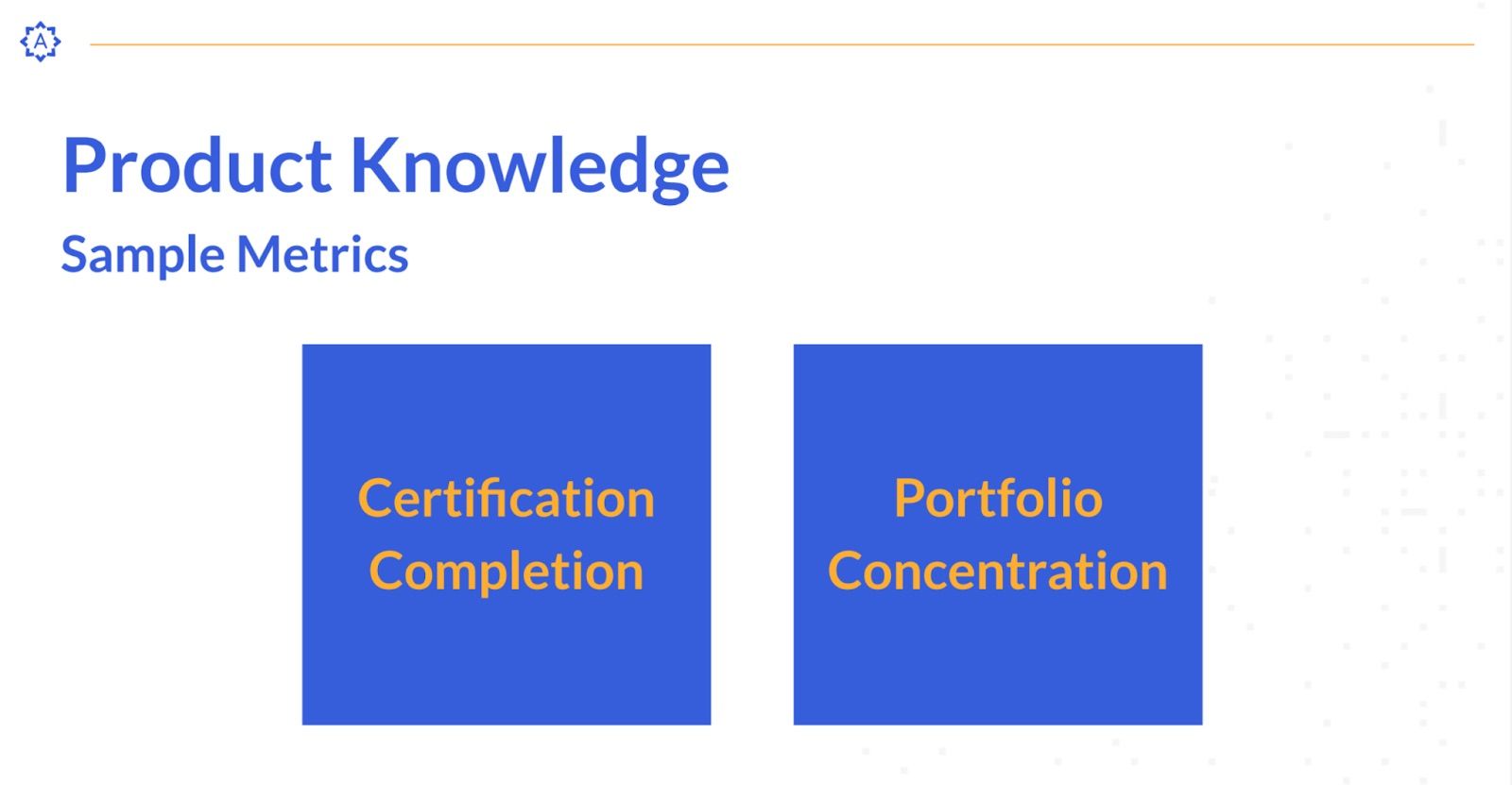
If your team is confident in their ability to pitch and sell products that ultimately is going to bring the revenue into the organization. This is one of the areas to help get there.
Using metrics
I mentioned already using metrics to inform your programming. Let me walk you through an example of one thing I did at Axiom.
Example: Axiom
I had this hypothesis that maybe our discovery process wasn't super-efficient. It was taking four meetings to get an opportunity generated and we were actually hoping it'd be closer to two.
It led me to believe our meetings just weren't super effective. I worked with our Rev Ops team and I asked them, "Hey, for all the new logos that we did in whatever year, can you pull all of this data for me, and let's dissect it and see where some areas of opportunity are".
We started off with, from the first time a BDR/SDR contacted a prospect to actually getting the meeting, how many days was that? And how many touches did it take?
We came up with a number. Then we said, if we improve that by 5%, how much revenue downstream will that impact? If you look at the fine print on the image below, we basically said:
- 5% better conversion would result in how many more meetings,
- Which translated to how many more wins, and we knew it took how many meetings per win to basically calculate that,
- Multiplied by the average in year revenue, or average deal size, however you measure that to ultimately determine
- 5% improvement would mean this many million in additional revenue.
We applied that same approach with outreach and closing.
- From a sales meeting to a new opportunity, how many days? How many meetings?
- And once the opportunity was created, how long it took to close.
If you look at the data and metrics that way and calculate the revenue impact we could have if we improve these things, executives would love to see that.
The CRO is not going to turn down an additional X million in revenue, with a relatively small percentage of improvement.
One of the things I'm thinking about at Andela is, if we want to focus on discovery, I'm going to spend the entire quarter focusing on discovery and that's what we're going to focus on and we're going to focus on that 5% improvement of our discovery efficiency and measure from there.
Program metrics
Don’t forget them
When it comes to program metrics, don't forget about them. Sheevaun Thatcher is the Head of Enablement at Ringcentral and she and I chatted a few years ago, one of the things she said that stuck out to me was, "If we can't measure the impact of a program, then we just don't do it".
It's similar to what I said at the beginning, metrics can be your bad cop if you're getting inundated with all of these requests that lack focus, have metrics be that focal point for you.
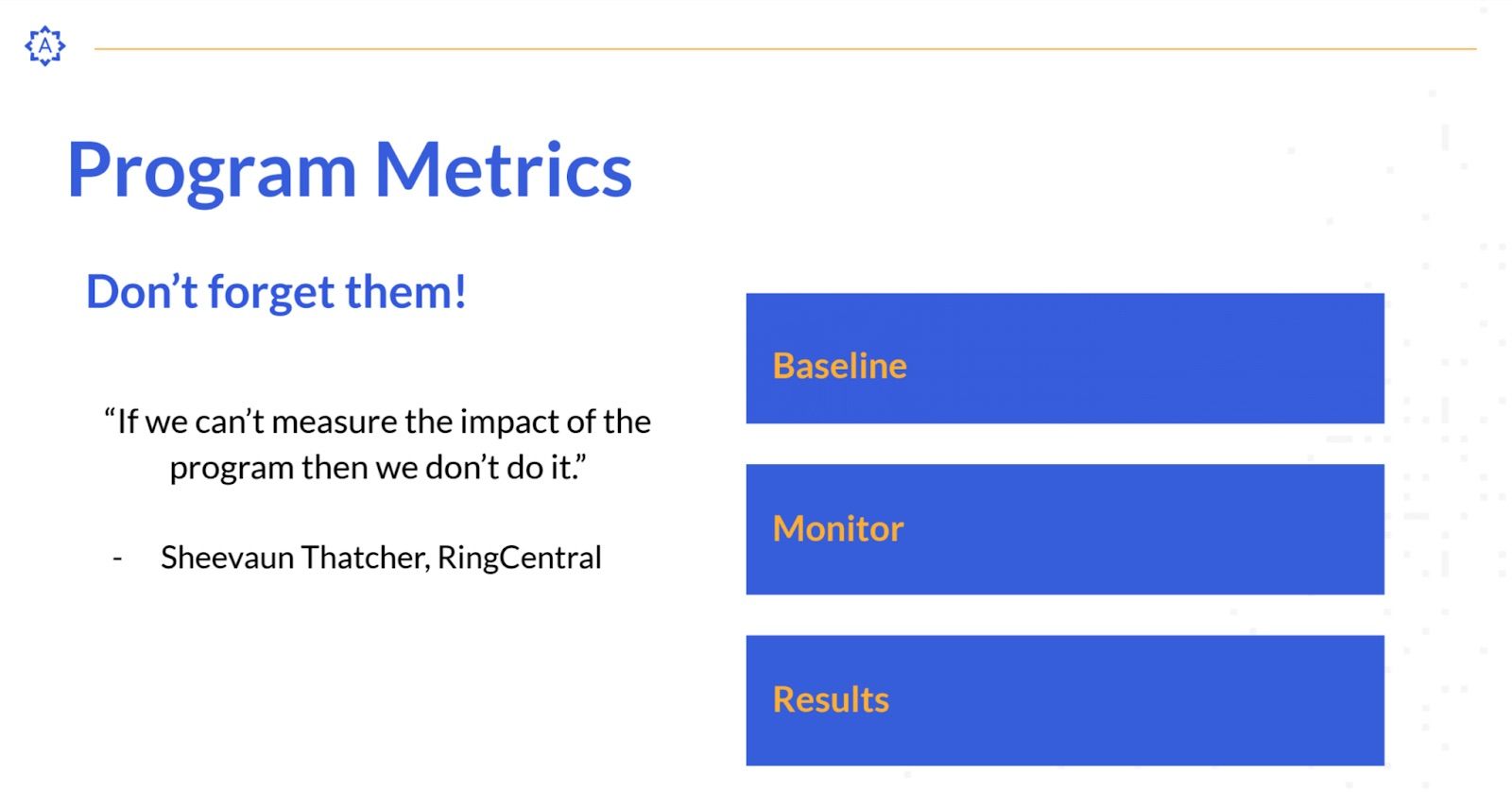
Let's take this discovery call program as an example.
Baseline
I'm going to have my baseline metric, let's say X number of days or X number of meetings to get from a meeting to an opportunity. That's my baseline.
Monitor
Then I'm going to spend a quarter with all of my different programming and coaching and different training materials and that sort of thing. I'm going to monitor the impact of that throughout the quarter.
Results
Then I'm going to have my results at the end of the quarter and hopefully, you're going to see the baseline has been improved and you can attribute that to revenue.
Program metrics are super important. Remember them, monitor them, publicize them.
Using that as your guiding light I think is a really great way to prove the efficacy of enablement.
Reporting
I haven't nailed reporting yet but I work very closely with Rev Ops to build reports and I'm going to be hopefully building a dashboard at Andela for all the metrics I have in my charter, so I can consistently see how I'm progressing, especially when I have programs in place.
Scorecards
At Axiom, one of the things we had was a scorecard. It was much larger than this, and honestly a little overwhelming, but we had all of the metrics we cared about on the left.
We had a team average and a benchmark. Then we had each rep as a column in the spreadsheet, and we could look at trend, see how they were performing quarter over quarter, and it helps us dig into "Okay, maybe there's something happening on a rep level, or is it a team level?", that sort of thing.
We had these scorecards come out every quarter at Axiom and the sales ops team would produce them.
I found them super helpful, especially paired with a talent review to have the qualitative and the quantitative when looking at individual rep performance.
Thank you.
Looking to become an enablement metrics whiz? Our Enablement Metrics: Masters course is made for you.
Master the metric mindset with this course and propel your sales enablement activities and impact to new heights.


